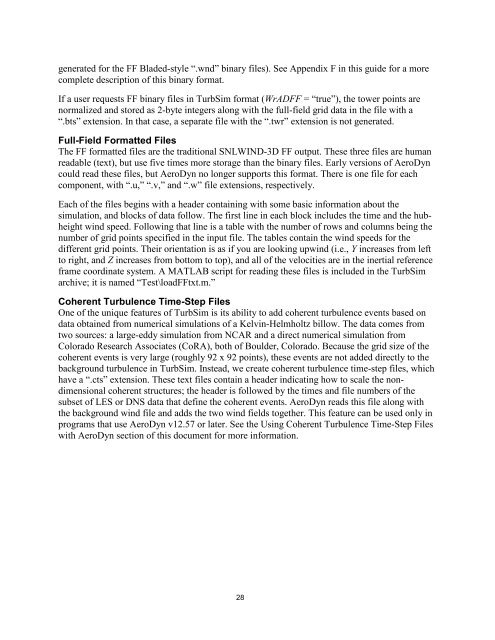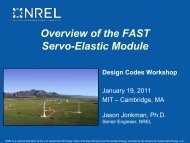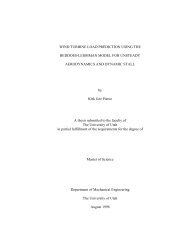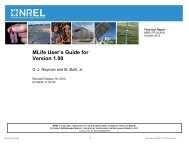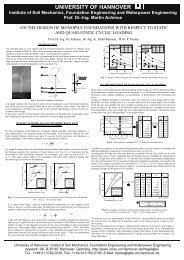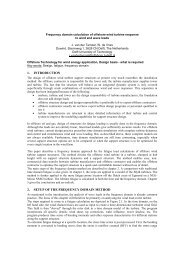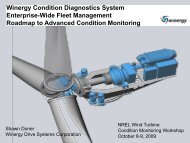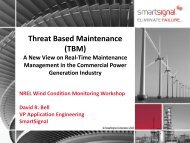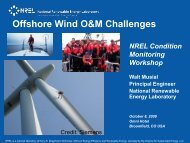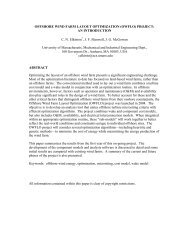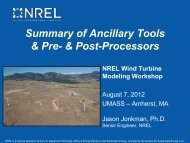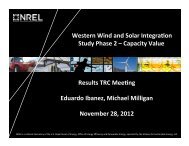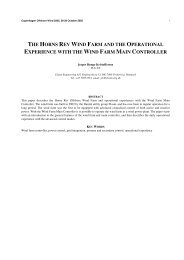TurbSim User's Guide: Version 1.06.00 - NREL
TurbSim User's Guide: Version 1.06.00 - NREL
TurbSim User's Guide: Version 1.06.00 - NREL
You also want an ePaper? Increase the reach of your titles
YUMPU automatically turns print PDFs into web optimized ePapers that Google loves.
generated for the FF Bladed-style “.wnd” binary files). See Appendix F in this guide for a morecomplete description of this binary format.If a user requests FF binary files in <strong>TurbSim</strong> format (WrADFF = “true”), the tower points arenormalized and stored as 2-byte integers along with the full-field grid data in the file with a“.bts” extension. In that case, a separate file with the “.twr” extension is not generated.Full-Field Formatted FilesThe FF formatted files are the traditional SNLWIND-3D FF output. These three files are humanreadable (text), but use five times more storage than the binary files. Early versions of AeroDyncould read these files, but AeroDyn no longer supports this format. There is one file for eachcomponent, with “.u,” “.v,” and “.w” file extensions, respectively.Each of the files begins with a header containing with some basic information about thesimulation, and blocks of data follow. The first line in each block includes the time and the hubheightwind speed. Following that line is a table with the number of rows and columns being thenumber of grid points specified in the input file. The tables contain the wind speeds for thedifferent grid points. Their orientation is as if you are looking upwind (i.e., Y increases from leftto right, and Z increases from bottom to top), and all of the velocities are in the inertial referenceframe coordinate system. A MATLAB script for reading these files is included in the <strong>TurbSim</strong>archive; it is named “Test\loadFFtxt.m.”Coherent Turbulence Time-Step FilesOne of the unique features of <strong>TurbSim</strong> is its ability to add coherent turbulence events based ondata obtained from numerical simulations of a Kelvin-Helmholtz billow. The data comes fromtwo sources: a large-eddy simulation from NCAR and a direct numerical simulation fromColorado Research Associates (CoRA), both of Boulder, Colorado. Because the grid size of thecoherent events is very large (roughly 92 x 92 points), these events are not added directly to thebackground turbulence in <strong>TurbSim</strong>. Instead, we create coherent turbulence time-step files, whichhave a “.cts” extension. These text files contain a header indicating how to scale the nondimensionalcoherent structures; the header is followed by the times and file numbers of thesubset of LES or DNS data that define the coherent events. AeroDyn reads this file along withthe background wind file and adds the two wind fields together. This feature can be used only inprograms that use AeroDyn v12.57 or later. See the Using Coherent Turbulence Time-Step Fileswith AeroDyn section of this document for more information.28


